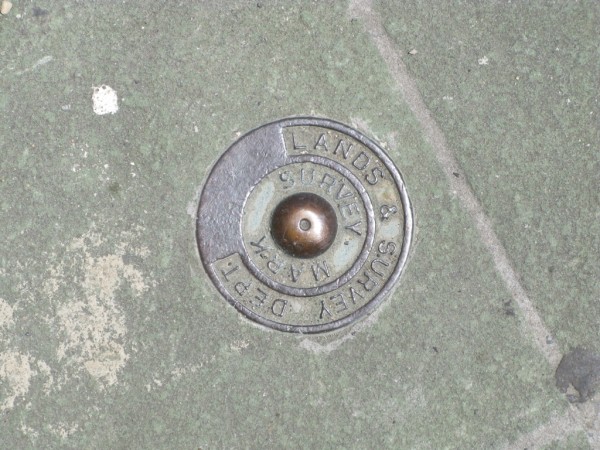What's a Land Surveyor?
Why you may need a land surveyor.
Ever wonder what a Land Surveyor does? Or why they're standing the middle of the road with a yellow tripod contraption? My dad, Clive Hopwood, is a Land Surveyor. He’s been doing it for as long as I can remember and has built an incredible reputation in San Diego. At an early age, he showed me the joy of construction and the endless professional possibilities. He’s a large reason I became a designer.
I’ve interviewed Dad many times since starting my architecture education, it was finally time to put pen to paper.
Ashley: What’s a Land Surveyor?
Clive: We have two main functions:
1) Determine property lines (PL). We verify existing PL’s or help subdivide and create new PL’s.
2) Map terrain. We produce topographic (topo) maps showing contours and other physical features.
This can be done for all types of projects from residential to retail to government construction. Often the two types of maps are combined to produce one grand map.
A: How do you produce these maps?
C: Well let’s use the example of a proposed single-family house. First, we research any maps that have been produced in that neighborhood. Those maps show nearby property markers. We then go out on site and find the markers. It could be in the middle of nowhere on a hundred acre property or it could be in the middle of an urban road. Here’s what they look like:
Once we document the markers and measure a whole bunch of other information on the site, we bring the information back to the office and produce a map showing whatever features the client has asked for. This could be topographic contours, large trees, power lines, etc.
Then the designer or engineer uses our map to design the house.
A: What do property owners do with the maps once they get permission to build?
C: Once they get a building permit, most clients use our maps to plan construction. Before building starts, we go out and physically map where major features will be built. This is when you see our wood stakes with colorful ribbons attached.
A: Why would a homeowner get a survey?
C: Property owners want to know their PL’s for various reasons. For example, if they want to build a fence or wall on the PL, you need to know where it is (duh). If they want to sell their property, the buyer often asks where the PL is and what their exact ownership will be. If they want to build any kind of structure on the land, the PL will determine the setbacks and allowable building area.
A: What’s the risk of not getting a survey?
C: For anything non-residential, it’s a huge risk. When you’re placing major utilities, large buildings, roads, etc, there’s very little margin for error.
For residential, it depends what they’re doing. If they’re building a wall or fence along the property line they might build it in the wrong place. If they build on a neighbor’s property and the neighbor suspects it’s misplaced, they could commission their own survey and the wall would have to come down. This applies to all private construction. Depending on the nature of the project, this demolition and rebuild can be extremely expensive. Additionally, a lot of public agencies require a survey so they can be sure the building conforms to setbacks and zoning regulations.
A: What does a residential survey cost?
C: Cost depends largely on how the parcel was initially created. For single family residential, the property is documented in two ways:
1) Before 1982, it was created by deed. The deed describes the property with written word.
2) After 1982, it was created by map. Like those site plans you see in every modern set of plans.
If the parcel was created by map, updating the map and adding physical features is fairly simple. Usually, this new map costs about $1500-$2000
If the parcel was created by deed, we have to create a Record of Survey. This means it is the first official map ever created for the property. This is a very involved process that includes extensive documentation and cooperation with the County Surveyor. Usually, this process costs about $2500-$6500. The exact cost depends on the simplicity of the deed description, size of the property, and nature of the terrain.
Terrain is a huge factor in both types of surveys. A parcel with little vegetation provides an easy line of site. High vegetation means higher cost. Also, hilly terrain can make the work much sweatier and time consuming so there’s extra cost to that, too.
A: How can homeowners find out if they’re on a deed or map?
C: They can look at the legal description on their Title Report. The Title Report defines the PL’s and any easements on the property.
If their property is on an existing map (post 1982), it will say so in the legal description. It will say “Map #1234, Lot #1234.” Homeowners can then go to the County Surveyor and find those maps.
If the homeowners finds a bunch of bearings and distances instead of map numbers, then their parcel was created by deed and will require a new Record of Survey.
A: How does a project progress through your office?
C: We take a call from a property owner and they want their PL established. If they’re doing a design, they also want a topo map and other major site features. We take relevant information like owner information, address, and parcel number and we start researching.
Luckily, San Diego County has all their maps online. We research any existing maps in the neighborhood plus a few more factors. It usually requires a couple days of research to give the client a firm price.
Once we’ve reached an agreement with the client, we dive into the project. Those county maps from our original research give us the location of nearby property markers. Then we create a map. See Question #2.
Commercial projects (shopping center, office building, etc) are basically the same process. We research, determine the PL, topography, etc and then hand it over to the designers. Our drawings form the basis of their design: the foundation, you might say. Haha. That’s why our map is essential. You really can’t do without it.
A: What are common misconceptions about Land Surveying?
C: Usually when we’re setup with our equipment in the middle of the street, people think we’re a film crew! The queue up and say, “will you take my picture?” That’s a laser, people! Not a camera. Haha.
A: Speaking of lasers, what technology do you use?
C: Lasers and GPS. When I started Land Surveying in 1978 (wow, 38 years ago), everything was measured with a theodolite (which measures angles) and a loooonnng tape measure.
Then laser measurement came and tape measures were out. That completely revolutionized the field. The laser instruments became more refined and eventually got their own data collector. Instead of having to write everything by hand, the data collector records everything and we bring it back to the office for download. That happened 35-40 years ago.
In the last couple decades, GPS has come to the forefront; another major shift in the industry. Over long distances, it’s far more accurate than the laser. It’s SO much better than the GPS on your phone or in your car. It’s accurate within 1/2 inch.
In our office we use a combination of lasers and GPS. GPS does not do well in heavily wooded or urban areas with high-rise buildings because our satellites are blocked. That’s when we bring in the lasers. Hah! That sounds like an Austin Power’s quote.
A: Where is the technology going?
C: Drones. That’s just started over the last several years. Again, it’s extremely accurate use of drones not your every day photography drone. It needs very sophisticated aircrafts, cameras, and software to analyze all that data. The technology is still fledgling but holds huge promise.
A: Now the fun stuff, what’s your favorite kind of job?
D: Ohhhhh, my favorite kind of job… haha. I suppose my favorite work is in the back country. It can be so beautiful and peaceful. Open, rolling hills with zero poison oak… that’s ideal.
A: What would you tell people thinking of becoming a Land Surveyor?
C: Surveying is for people who love the outdoors. It’s fairly technical but doesn’t require any crazy math. The process of surveying isn’t very complex but every job is different. It keeps you on your toes all the time. Days pass quickly because there’s a lot of concentration and planning involved. Mistakes can be very costly and the work is physically and mentally challenging. That being said, anybody who loves being in the great outdoors and/or the bustle of construction sites should consider this profession.
A: You like it?
C: Oh I absolutely love it. It was made for me and I was made for it.




